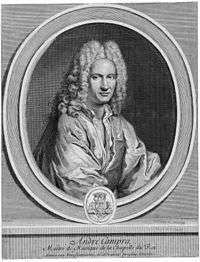Tancrède
| Operas by André Campra |
|---|
 |
|
Tancrède is a tragédie en musique (a French opera in the lyric tragedy tradition) in a prologue and five acts by composer André Campra and librettist Antoine Danchet, based on Gerusalemme liberata by Torquato Tasso.
The opera contains 23 dances in addition to the singing, but is famous for the alleged first contralto role in French opera (though in modern terms more of a mezzo-soprano range) written for Julie d'Aubigny, known as 'La Maupin', the most colorful singer of this era, or any other.[1] It's also notable for the unusual choice of three low-lying voices for the main male parts.
Performance history
Tancrède was first performed on 7 November 1702 by the Académie Royale de Musique at the Théâtre du Palais-Royal in Paris under the direction of Marin Marais. It was successful and remained in the repertoire until the 1760s.
Roles
| Role | Voice type | Premiere Cast, 7 November 1702[2] (Conductor: Marin Marais) |
|---|---|---|
| A sage enchanter/A warrior | haute-contre | Jacques Cochereau |
| Peace | soprano | Mlle Clément L. |
| Followers of Peace | sopranos | Mlles Clément P. and Loignon |
| Tancrède, a crusader | bass-baritone | Gabriel-Vincent Thévenard |
| Argante, Saracen leader | bass-baritone | Charles Hardouin |
| Clorinde, Saracen princess | contralto[1] | Julie d'Aubigny (La Maupin) |
| Herminie, daughter of the king of Antioch | soprano | Marie-Louise Desmatins |
| Ismenor, Saracen magician | bass-baritone | Jean Dun "père" |
| Female warriors | sopranos | Mlles Dupeyré, Lallemand and Loignon |
| A sylvan | haute-contre | Antoine Boutelou |
| Two dryads | sopranos | Mlles Loignon and Bataille |
| A nymph | soprano | Mlle Dupeyré |
| Vengeance | tenor (travesti) | Claude Desvoyes |
References
- Notes
- 1 2 The part of Clorinde is notated in the soprano clef (original score, p. 71), but, although it never descends below d′, tradition has it that it was the first major bas-dessus (contralto) role in the French opera history (Sadie, Julie Anne, Maupin, in Sadie, Stanley (ed), op. cit., III, p. 274).
- ↑ According to Le magazine de l'opéra baroque.
- Sources
- Original printed score: Tancrede , tragedie, mise en musique par Monsieur Campra. Représentée pour la premiere fois par l'Academie royale de musique le septiéme jour de novembre 1702, Paris, Ballard, 1702 (accessible for free online at Gallica - B.N.F.)
- Anthony, James R (1992), 'Tancrède' in The New Grove Dictionary of Opera, ed. Stanley Sadie (London) ISBN 0-333-73432-7
- Casaglia, Gherardo (2005).[http://www.amadeusonline.net/almanacco?r=&alm_giorno=07&alm_mese=11&alm_anno=1702&alm_testo=Tancr%E8de "Tancrède, 7 November 1702"]. Almanacco Amadeus (Italian).
- Le magazine de l'opéra baroque, page: Tancrède
